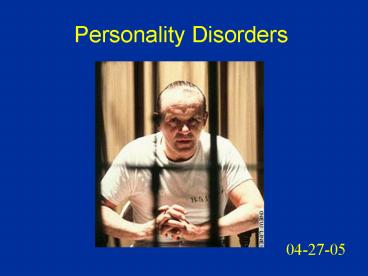Personality Disorders - PowerPoint PPT Presentation
1 / 16
Title:
Personality Disorders
Description:
Ted Bundy. Richard Ramirez. APD vs. Psychopathy. Studies have used different samples and different definitions of antisocial tendencies ... – PowerPoint PPT presentation
Number of Views:88
Avg rating:3.0/5.0
Title: Personality Disorders
1
Personality Disorders
- 04-27-05
2
Etiology of Psychopathy andAntisocial
Personality Disorder
Ted Bundy
Richard Ramirez
3
APD vs. Psychopathy
- Studies have used different samples and different
definitions of antisocial tendencies - Terms APD and psychopathy have been used
interchangeably by DSM-IV and others - DSM-IV conceptualizations of APD focus on
behavioral manifestations and criminality (3-5
of male population) - Psychopathy is a more reliable and specific
construct with greater predictive validity (1 of
population) - Most psychopaths engage in antisocial behavior,
but most APD do not have personality traits of
psychopathy
4
Antisocial Personality Disorder
- Pervasive pattern of disregard for and violation
for the rights of others since age 15, indicated
by 3 or more of the following - 1) failure to conform to social norms with
respect to lawful behaviors repeatedly
performing acts that are grounds for arrest - 2) deceitfulness repeated lying, use of
aliases, conning others for personal profit or
pleasure - 3) impulsivity or failure to plan ahead
5
Antisocial Personality Disorder
- 4) irritability aggressiveness (e.g., repeated
physical fights or assaults) - 5) reckless disregard for safety of self or
others - 6) consistent irresponsibility repeated failure
to sustain work or honor financial obligations - 7) lack of remorse being indifferent to or
rationalizing having hurt, mistreated, or stolen
from another - At least 18 years old, evidence of Conduct
Disorder before age 15, no Schizophrenia or Manic
Episode
6
3-Factor Model of Psychopathy
Psychopathy
Arrogant Deceitful Interpersonal Style
Impulsive Irresponsible Behavioral Style
Deficient Affective Experience
7
Features of Psychopathy
- Interpersonal
- Superficial
- Grandiose
- Deceitful
- Egocentric
- Manipulative
- Deceptive
- Intimidating
- Callous
- Affective
- Shallow, labile
- No empathy
- Lack of guilt
- or remorse
- Little stress
- Weak emotional ties to people
- Behavioral
- Impulsive
- Sensation-seeking
- Lack of realistic, long-term goals
- Violation of social norms
8
Etiological factors in APD Psychopathy
- Family/Socialization
- Genetic
- Autonomic Nervous System Abnormalities
- 1) Fearlessness / Lack of Anxiety
- 2) Arousal / Sensation-seeking
9
Family/Socialization
- Lack of parental affection / supervision
- Parental rejection
- Inconsistent / inadequate discipline
- Modeling by a parent with antisocial behaviors
(especially father)
10
Genetic
- Twin studies higher concordance for MZ than DZ
twins - Adoption studies higher concordance for
biological than adoptive relatives (especially
fathers)
11
Autonomic Nervous System Abnormalities
- Deficiencies or abnormalities in the functioning
of the ANS may predispose individuals to develop
antisocial tendencies - 1) Fearlessness / Lack of Anxiety
- 2) Arousal / Sensation-seeking
12
Fearlessness / Lack of Anxiety
- ANS abnormalities may make psychopaths less
susceptible to anxiety - Lack of anxiety interferes with avoidance
learning (i.e., learning through punishment) - Psychopaths appear less likely to learn from
their experiences through punishment (e.g.,
Lykkens classical conditioning studies, pp.
251-252)
13
Arousal / Sensation-seeking
- Low levels of ANS reactivity may keep antisocial
people emotionally underaroused - Exciting, thrill-seeking, impulsive, or
unconventional behaviors might stem from efforts
to achieve an optimal level of arousal or to
avoid boredom - Research shows that psychopaths require a more
intense stimulus to elicit ANS reactivity
14
Factors influencing learning deficits
- Arousal level When arousal level was increased
with adrenaline, psychopaths performed better
than nonpsychopaths on an avoidance learning task
(p. 254) - Kind of punishment Learning deficits emerge with
physical and social, but not with monetary,
punishments - Certainty of punishment Less certainty is
associated with more deficits (i.e., threats
dont work)
15
Impulse Control Disorders
- Intermittent Explosive Disorder
- Kleptomania
- Pathological Gambling
- Pyromania
- Trichotillomania
16
Impulse Control Disorders
- Failure to resist an impulse or temptation to
perform some act, although they know it is
considered wrong by society or is harmful to them - Experience of tension or arousal before the act
- Sense of excitement, gratification, or release
after committing the act































